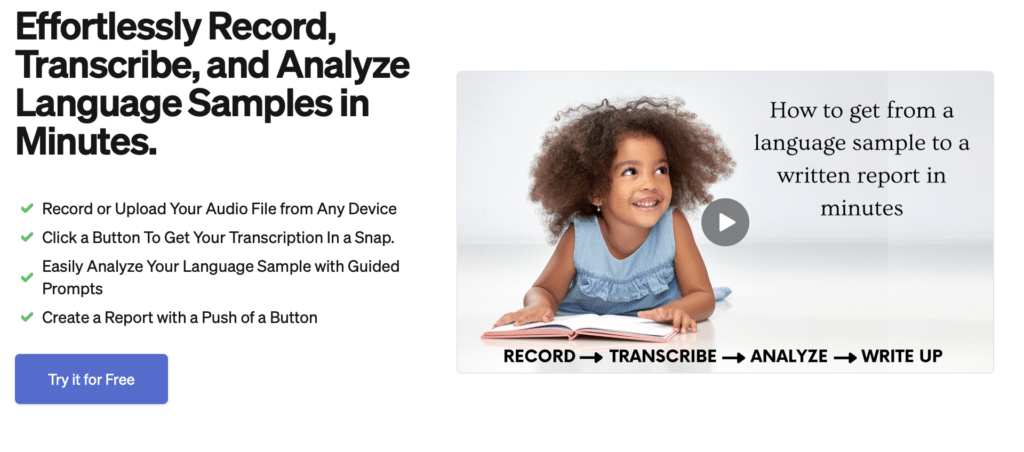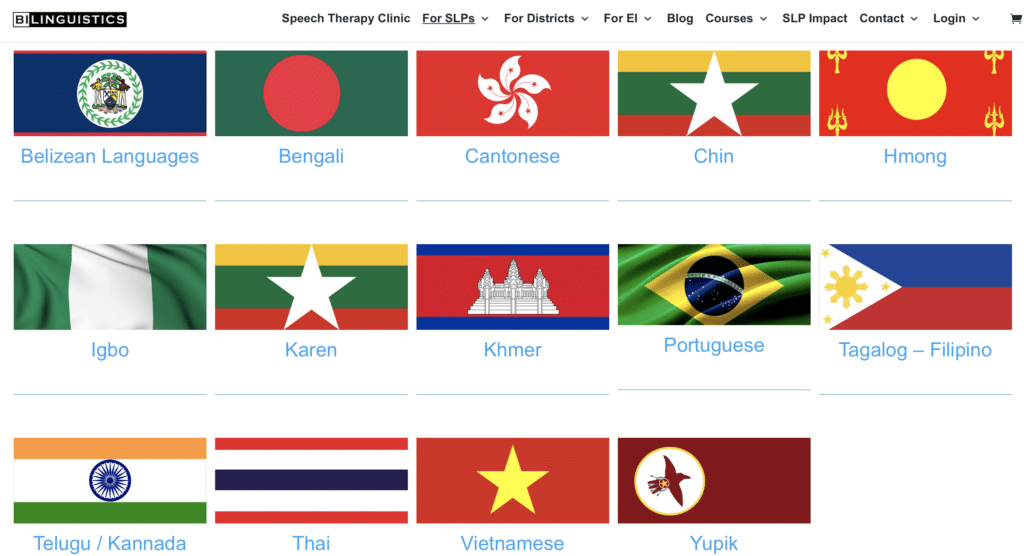Language samples are an invaluable tool in speech-language evaluations, providing a more authentic assessment of a child’s linguistic abilities compared to standardized tests. However, many speech-language pathologists (SLPs) find language samples time-consuming and challenging to analyze. Despite these difficulties, research continues to affirm that language samples offer deeper insight into a child’s language skills, particularly for dual language learners (DLLs). That’s why we’re working to amass language sample resources to get everyone the information they need to complete them fast and effectively.
I’ve been in this field for 30 years and I’ve done a LOT of language samples in those years. I shudder to think about the number of hours I’ve committed to transcribing and analyzing language samples. It’s all time well spent though, as I feel very confident in my diagnostic decisions when take the time to really understand what my students authentic language skills look like. I want to share some great resources with you in this post, including one that will shave hours of time out of your transcription and analysis process.
So check out these courses on language sample resources that focus on really advanced ways to account for culture, serve as a major portion of their evaluation, and reduce their caseload.

Language Sample Resources that Will Make Your Diagnostics Take Off
These three exceptional courses will empower SLPs with practical tools and research-backed strategies for conducting and analyzing language samples. Each course is led by an expert in the field, covering critical aspects of language sample analysis, re-evaluations, and assessments for multilingual youth.
1. Bilingual Language Sample Analysis: Large-Scale Data & Clinical Decision-Making
A major challenge for SLPs working with bilingual children is determining what constitutes typical communication. Fortunately, research has provided extensive databases that SLPs can use to compare a child’s results with those of typically developing peers. Dr. Raul Rojas, an expert in bilingual language development, provides a step-by-step guide to conducting bilingual language sample analysis (LSA) using these reference databases. We captured the highlights of an interview with Raul in these three videos.
What You’ll Learn:
- How to use bilingual LSA as an assessment tool for dual language learners.
- Methods for leveraging large-scale reference databases to evaluate language development.
- Differences in dual language development profiles and how to interpret them in assessments.
Why This Course Matters:
Children who are DLLs represent a growing demographic in the U.S., and their accurate assessment is critical. Many standardized tests do not account for bilingual language growth, leading to misdiagnosis and inappropriate interventions. This course equips SLPs with data-driven approaches to assessing dual language learners effectively.
2. Re-Envisioning Re-Evaluations: Strategic Use of Resources to Reduce Caseloads
Re-evaluations are essential in determining whether students continue to require speech-language services. However, many SLPs struggle with heavy caseloads, making re-evaluations a daunting task. In this course, Scott Prath provides actionable strategies to streamline the re-evaluation process, allowing SLPs to make accurate, timely decisions about student progress and potential dismissals.
What You’ll Learn:
- The key differences between initial evaluations and re-evaluations.
- How to incorporate language sample data into re-evaluations to make informed decisions.
- How to effectively use progress monitoring, IEP meetings, and existing student data to streamline the re-evaluation process.
Why This Course Matters:
Many students remain in special education services longer than necessary due to inefficiencies in the re-evaluation process. By refining assessment methods and leveraging language sample resources, SLPs can make better-informed decisions about dismissing students or refining intervention goals.
3. Using a Translanguaging Approach to Assess Language Skills in Multilingual Youth
Translanguaging is a critical concept for assessing multilingual youth, allowing them to use their entire linguistic repertoire to demonstrate their language abilities. Dr. Cecilia Perez explores how SLPs can implement a translanguaging approach when assessing bilingual adolescents, particularly in culturally relevant contexts.
What You’ll Learn:
- How to define and apply a translanguaging framework in speech-language assessments.
- Ways to incorporate language sampling techniques that reflect bilingual students’ full linguistic abilities.
- The benefits of using culturally relevant narratives, such as fables and corridos, to assess language complexity and critical thinking.
Why This Course Matters:
Traditional assessments often fail to capture the dynamic language abilities of multilingual students. This course presents innovative methods to assess bilingual adolescents in ways that affirm their linguistic and cultural identities, ensuring a more accurate and equitable evaluation process.
Maximize Your Professional Development Today
Language sample resources provide unparalleled insights into a child’s language abilities, yet many SLPs struggle with how to implement them efficiently. These three courses will equip you with the skills and knowledge needed to conduct accurate, culturally relevant assessments while also streamlining your workflow. Whether you are working with dual language learners, refining your re-evaluation strategies, or exploring translanguaging approaches, these courses will transform your practice.
A Tool that Transcribes for you and Guides your Language Sample Analysis
Yes, of course, now for the tool I promised to share with you at the beginning. Over the past few years, we’ve been working on a report writing tool called Evalubox. It like a box full of tools that make speech-language evaluations easier. You can use the tools independently or within the Evalubox writing system. The one I want to share with you today is really cool. I about fell out of my chair the first time I used it.
It’s the Evalubox Transcription and Analysis Tool. I uploaded an audio file of a language sample, clicked a button, and within seconds I had a transcript. Insane! If only I could get all of the hours I spent transcribing language samples back! Oh well, I’m happy enough with the time it saves me now. I upload my file, edit it in the system, and then walk through the very easy-to-use language sample analysis and the system generates a great report for me to include in my evaluation. Pretty cool.
The Evalubox Language Sample Transcription Tool Detects the Language Spoken
One other very cool feature of the Evalubox system is that it detects the language spoken in the language sample. Are you doing an evaluation in Spanish? No problem. Just record it and click the button for Evalubox to produce a transcript in Spanish.
At Bilinguistics we are feeling the diversity this year more than ever! So far this year we’ve been asked to conduct evaluations in French, Mandarin, Arabic, Vietnamese, Spanish, Albanian, Japanese, and Marathi. When working with translators, which we obviously have to do for most of these, we can upload the file, let Evalubox create the transcription.

Then, walk through it with the interpreter immediately using language information from the Bilinguistics World Language Library. In years past I always had to wait for my interpreter/translator to go home, download the file, transcribe, and send. Now, we can knock it out very quickly and easily. Jump in and try it. You can sign up for a free account and it will give you a few free credits to try it out.
World Language Library

